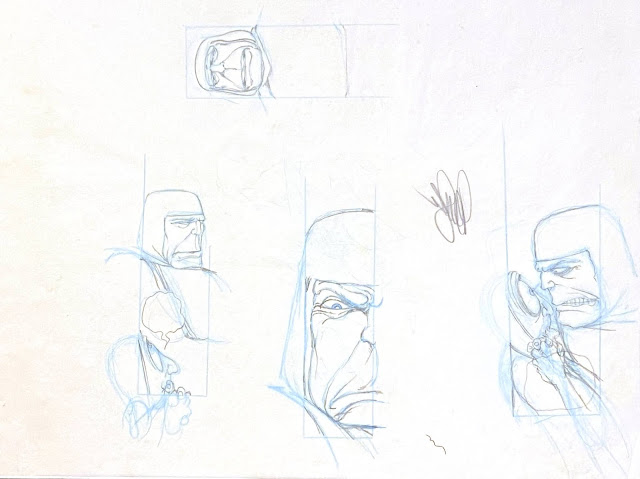So way back in October of 2014 we saw pages from Dave Sim’s 11th Cerebus notebook which we are going to discuss again here. That notebook, earlier called #8 before I relabeled them all ‘notebook’ and not ‘albatross’, covers Cerebus #96 to 102, it contain 129 pages of the 140 it started with, and of those 129 pages, only 114 were scanned as there were a bunch of blank pages.
The page we’re going to look at again is page 51:
 |
| Notebook #11, page 51 |
Which we originally saw in The Trial many years ago. I compared it to the finished pages, Cerebus #98, pages 6 and 7, yes, a double page spread. Now though, we can look at the in-between step: the tracing paper. Dave would draw on the tracing paper, flip it over so the pencil that is on the tracing paper is on the Bristol board art page, and then he would pencil on top of the pencil that he could see on the other side of the tracing paper.
Here is the tracing paper, which measures 14” x 11” (35.6 cm x 27.9 cm). First up is the side that “looks right” in that it the same as the finished page. This was done in blue pencil:
 |
| Tracing paper, blue pencil side |
The next picture is of the same sheet of tracing paper, but is backwards of the finished page. You can see that the black pencil is more prominent on this page:
 |
| Tracing paper, black pencil side |
Here is what Dave has to say on his usage of tracing paper, taken from his note that came with a tracing paper preliminary pencil drawing used in Cerebus #300, you can view the entire note here.
Throughout the 26-year-and-3 month production of the 6,000-page Cerebus storyline, as a comic-book illustrator, I went through a number of phases and different techniques which I used in penciling and inking the characters. For example, for a long period of time, I used non-reproduction blue pencil to “rough in” and gesture of the characters I needed to depict and would then “tighten up” the drawings in soft lead pencil prior to inking them. And then, for a period of time, I dispensed with the blue pencil and went right to lead pencil both for layout and tight penciling.
During one of these phases, I also began to use tracing paper as a means of correcting imbalances and inaccuracies in the drawings. This technique involved getting a close approximation of how I intended the finished drawing to look and then flipping the tracing paper over and either drawing a finished version of the figure directly on the other side of the sheet or putting another sheet of tracing paper over the first one and doing the finished version on that separate sheet. When a final version of a figure was achieved (in reverse), the finished drawing was then turned face down on the artboard and—by tracing over the image in pencil—a light pencil impression of the finished drawing was transferred to the artboard which could then be “tightened up” in pencil and inked.
To get another look at the tracing paper and the finished page in the issue (well, phonebook here, page 942 of Church & State II):
 |
| Yes, you can clickity click to see all these images bigger |
At some point Dave stopped using the blue pencil for the tracing paper prelims and used black pencil for both sides, though I don’t know where exactly. He would throw the tracing papers away. Only during the creation of Cerebus #256 through 259 did he start to send them to people who wrote to him. Sending a form letter and a tracing paper sketch was his way of making up for not sending a personalized letter in return:
 |
| “Dear CEREBUS Correspondent” |
Talk about giving me a heart attack. Even back in mid-2000 when I received this form letter. Yes, Dave – PLEASE do not throw them away. Yoinks! So the ones from Church & State II are probably few and far between. I’m not sure how this one survived, just that Dave sent it to me many years ago. I hope he still has some of them up in the Off White House.

6 comments:
Dave also made a video of this process: https://youtu.be/JgTN6oEUEAU
Thanks for posting, Margaret!
Dave Sim: I completely disagree with the term "homophobia" since a "phobia" implies fear. The natural reaction to homosexuality isn't fear, but repulsion, disgust. If I'm walking down the street and I see a pool of vomit on the sidewalk, the most natural reaction is repulsion. I don't hate the vomit, I'm not afraid of the vomit, I am repelled by the vomit. Which is a natural, sensible reflex reaction. The very recently-innovated notion of "homophobia" implies that my natural, sensible reaction is wrong -- that is, that I should learn to overcome my repulsion for the pool of vomit, force myself into closer proximity to the specific pool of vomit and into a greater acceptance of vomit in general. "Look, Dave. The pool of vomit isn't going to hurt you. The pool of vomit is completely natural, as much a part of life and living as you are. Here, put your hand in it. Let me show you."
http://momentofcerebus.blogspot.com/2016/04/getting-riel-with-chester-brown-part-two.html
As always, Dave considers himself the measure of all things -- "self-projection as god".
-- Damian
Cool tracing paper images! Always interesting to see the methods cartoonists employ when creating comics.
-- Damian
I also enjoy hearing about the "nuts and bolts" of making comics; that's part of why I am a big fan of SDOAR.
Indeed, Tony! Other valuable texts relevant to this blog include Dave's Cerebus Guide to Self-Publishing and Sean Robinson's "How to scan and restore comics".
-- Damian
Post a Comment